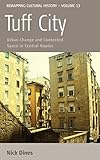Tuff City : Urban Change and Contested Space in Central Naples / Nick Dines.
Material type: TextSeries: Remapping Cultural History ; 13Publisher: New York ; Oxford : Berghahn Books, [2012]Copyright date: ©2012Description: 1 online resource (364 p.)Content type:
TextSeries: Remapping Cultural History ; 13Publisher: New York ; Oxford : Berghahn Books, [2012]Copyright date: ©2012Description: 1 online resource (364 p.)Content type: - 9780857452795
- 9780857452801
- 307.760945731 23
- online - DeGruyter
| Item type | Current library | Call number | URL | Status | Notes | Barcode | |
|---|---|---|---|---|---|---|---|
 eBook
eBook
|
Biblioteca "Angelicum" Pont. Univ. S.Tommaso d'Aquino Nuvola online | online - DeGruyter (Browse shelf(Opens below)) | Online access | Not for loan (Accesso limitato) | Accesso per gli utenti autorizzati / Access for authorized users | (dgr)9780857452801 |
Frontmatter -- Contents -- Illustrations -- Maps -- Abbreviations -- Preface -- Introduction -- Part 1. Urban Change in an Ordinary City: Naples during the 1990s -- Chapter 1 The Centro Storico History of a Concept and Place -- Chapter 2 Between the General and the Particular A Neapolitan Version of ‘Urban Regeneration’ -- Chapter 3 The Left, the Politics of Citizenship and Shifting Ideas about Naples -- Chapter 4 Public Space and Urban Change -- Part 2. The Making of a Regeneration Symbol: Heritage, Decorum and the Incursions of the Everyday in Piazza Plebiscito -- Chapter 5 Enter the Historic Piazza -- Chapter 6 From Royal Courtyard to Car Park -- Chapter 7 The Regeneration of Piazza Plebiscito -- Chapter 8 Sous les Pavés, la Place! An Ethnography of the New Piazza Plebiscito -- Chapter 9 Exit Piazza Plebiscito Rethinking ‘Civic’ Space -- Part 3 Deprovincializing Urban Regeneration Piazza Garibaldi and Immigration during the Bassolino Era -- Chapter 10 Enter the Station Piazza -- Chapter 11 Antechamber to the Southern Italian Capital (1860–1994) -- Chapter 12 Piazza Garibaldi as an Unregenerate Space (1994–2001) -- Chapter 13 Mapping Immigrant Experiences In and Of Piazza Garibaldi -- Chapter 14 Exit Piazza Garibaldi (Re)connecting Immigration and Urban Renewal -- Part 4. An Alternative Idea of Public Space: The Centro Sociale in Montesanto -- Chapter 15 Enter a Neighbourhood Park -- Chapter 16 The Popular Neighbourhoods in the Twentieth Century -- Chapter 17 Diego Armando Maradona Montesanto (DAMM) Collective Action over Public Space in Montesanto -- Chapter 18 Exit DAMM The Constitutive Role of Collective Action upon Public Space -- Conclusion Rethinking Urban Change in Late Twentieth-century Naples -- Glossary of Italian Terms -- Bibliography -- Index
restricted access online access with authorization star
http://purl.org/coar/access_right/c_16ec
During the 1990s, Naples’ left-wing administration sought to tackle the city’s infamous reputation of being poor, crime-ridden, chaotic and dirty by reclaiming the city’s cultural and architectural heritage. This book examines the conflicts surrounding the reimaging and reordering of the city’s historic centre through detailed case studies of two piazzas and a centro sociale, focusing on a series of issues that include heritage, decorum, security, pedestrianization, tourism, immigration and new forms of urban protest. This monograph is the first in-depth study of the complex transformations of one of Europe’s most fascinating and misunderstood cities. It represents a new critical approach to the questions of public space, citizenship and urban regeneration as well as a broader methodological critique of how we write about contemporary cities.
Mode of access: Internet via World Wide Web.
In English.
Description based on online resource; title from PDF title page (publisher's Web site, viewed 25. Jun 2024)


